The customer chose to protect their confidential information
An Advanced VOD Solution for a Telecom Business

About the client
Andersen was approached by a B2B/B2C Telecom business from the DACH region. The company provides a large spectrum of services: fixed-network/broadband, mobile communications, Internet, and IPTV products for consumers, as well as information and communication technology (ICT) solutions for its business and corporate clients. The company operates in the markets of 11 countries and has over 100,000 employees, most of whom are located in Bonn and Vienna.
![[object Object] on the map](https://static.andersenlab.com/andersenlab/new-andersensite/bg-for-blocks/about-the-client/switzerland-desktop-2x.png)
About the project
Specialists
- 3 Front-end/React developers
- 5 Back-end/Java developers
- 2 iOS/Swift developers
- 2 Android/Kotlin developers
- 2 Android developers: Android TV
- 2 iOS/Swift developers: Apple TV
- 2 .NET developers: Tizen
- 2 Web developers (HTML/JavaScript/CSS): webOS
- 1 Solution Architect
- 1 DevOps engineer (AWS)
- 2 BA/SA specialists
- 2 QA engineers
- 1 UI/UX designer
- 1 PM
- 1 DM
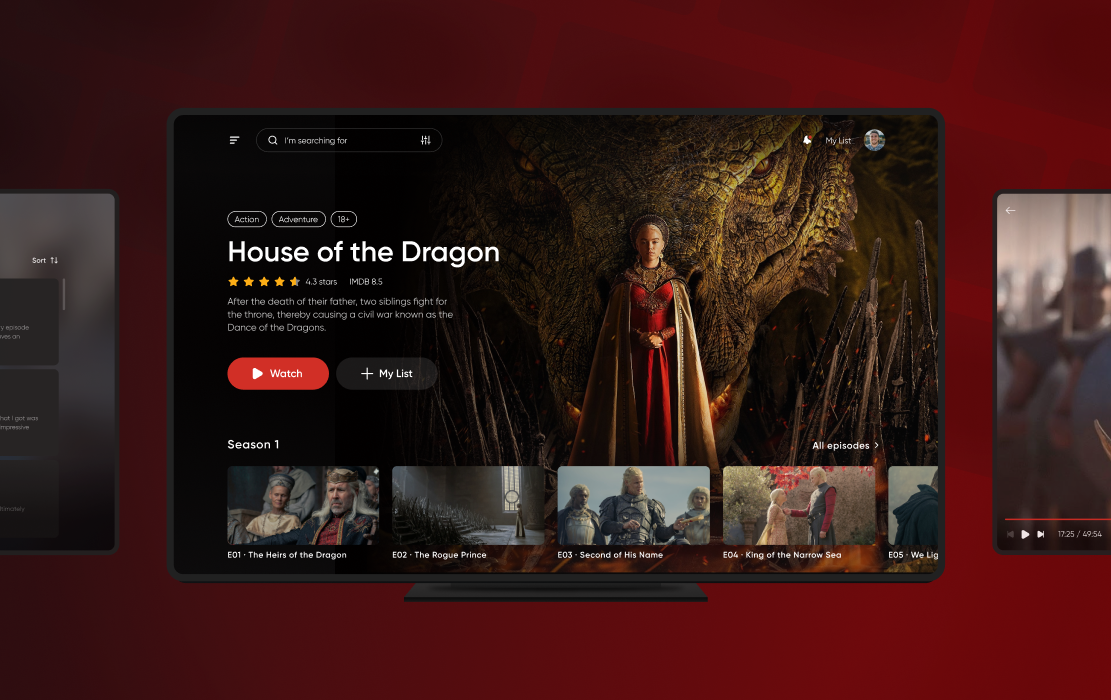
Project details
Business problem.
The customer is a well-known provider of Telecom services with huge experience in media broadcasting using conventional methods (TV, radio, etc.). However, a decreased demand for the consumption of information from these sources led to losses in revenue caused by lower broadcasting rates, audience withdrawal, and a reduced number of advertisements and promotion agreements. These were the key drivers that made the company embrace a modern approach towards digitalization.
How it has influenced the customer’s business.
The increasing popularity of VOD (video-on-demand) and streaming solutions in the OTT (over-the-top) market led to a lost opportunity for the customer’s business, as it didn't have a platform that could provide users with easy access to the media content online. The company was also lacking the ability to share content with broader audiences, increase content monetization, and attract advertisers via a VOD platform.
Opportunity.
The customer's idea was to diversify the business by developing a custom OTT platform that would augment the existing pool of content delivery tools. Such a platform was expected to provide high-quality VOD services enabling users to easily access the media content (streams, films, TV series, etc.) on all types of devices (web, mobile, and Smart TV). For the customer’s business, this would provide an opportunity to distribute its content among more people and hence gain a major share of the entertainment services market and better capabilities for video monetization and ad integration.
Goals.
The supreme goal was to increase the company's revenue and make it a leader among VOD service providers by developing a custom OTT platform that would be easy to modify and highly adaptive to user needs. The major business objectives set by the customer were:
- Guarantee high-level security of the content. The solution was supposed to effectively restrict or complicate various illegal actions with video in the digital format to protect copyright and avoid revenue losses.
- Allow for subsequent changes. This VOD solution needed to be scalable, highly adaptive to accommodate the possible modification of functionality, and easy to customize for specific business needs by decreasing the number of third-party integrations.
- Withstand high load. The solution was expected to be able to deal with a large number of users simultaneously (around 10,000) without performance losses while ensuring low response time and a reduced number of errors.
Furthermore, user interviews and analysis of feedback in app stores, which had been conducted by our Business Analysts during the Discovery phase, revealed a couple of key user requirements:
- Simplify the process of choosing the content by reducing the users' time and effort to pick relevant material. The solution was expected to provide users with all the tools required to choose content in an effortless manner and avoid searching for suggestions on forums or recommendation websites.
- Provide availability of the content for a broad range of devices (web, mobile, and Smart TV). This VOD software was required to be available on all major platforms, including different operating systems, models of devices, screen resolutions, etc.
Current trends on the market
The growing market of OTT solutions is expanding both locally – in the DACH region – and globally. The majority of companies are either turning to white-label solutions with limited customization or opting to create a platform from scratch, which gives more space for possible changes and improvements. Furthermore, most content makers give preference to streaming platforms as a fast and efficient means of monetizing their content due to the easy spreading and promotion of works. As a result, many OTT platforms accumulate enough resources to invest in the production of their own content and compete with professional filming studios (e.g., Netflix).
Solution
Thanks to our contribution, the company can now benefit from a custom VOD streaming platform tailored specifically to its business needs, as well as to the plans of the company's marketing department and user preferences. Andersen's solution includes features for diverse VOD-related operations and the following user types:
- Administrator – uploads, stores, and manages the content, ensures the security of the content, distributes the materials, and performs reporting and analytics.
- Viewer – searches for relevant content via a recommendation engine, views and assesses the materials, and pays for the subscription.
Among other features, the resulting VOD solution offers the following advantages:
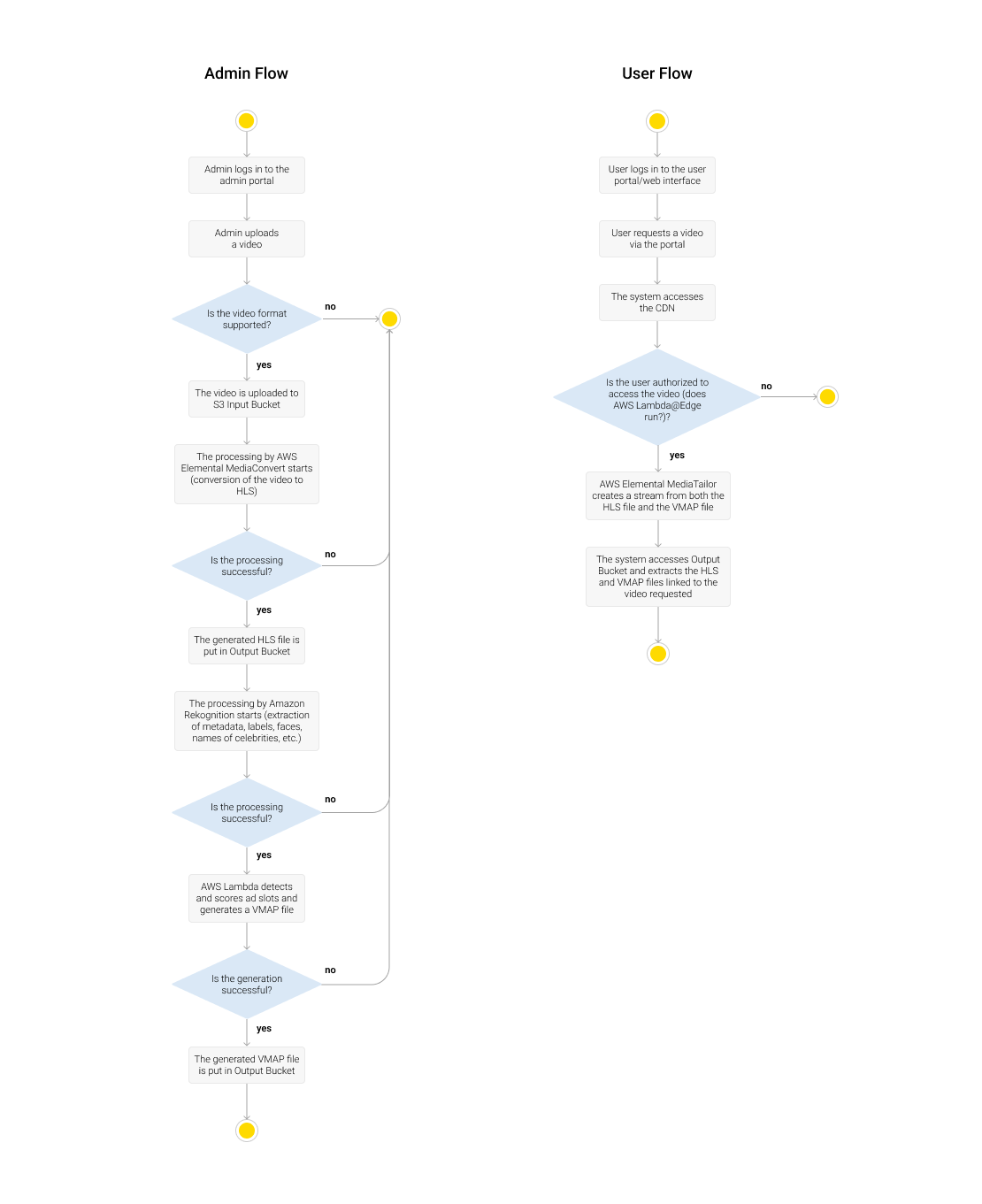
Properly adopted content monetization models
Together with our Business Analysts, the customer's team selected multiple monetization models meant to provide users with a variety of options for accessing the platform’s content. The SVOD (subscription video-on-demand) model was adopted as a primary solution due to its high level of flexibility and freedom and the benefits from the features of the Membership Economy (including super users, so-called forever transactions, and recurring revenue). Notably, it was augmented by the AVOD (ad-based video-on-demand) model, which has two options: access to all content at a reduced subscription price with the ads-included feature or access only to free-to-view content with integrated advertisements. Such a decision served three major purposes: embracing a larger audience due to the increased availability of content, testing new approaches, and offsetting the hosting costs. The TVOD (transactional video-on-demand) model was applied to provide access to premium content and new releases outside subscription limitations. All of the above have made it possible to gain a larger market share, obtain viewers' feedback, and adjust the business model specifically to the users' demands.
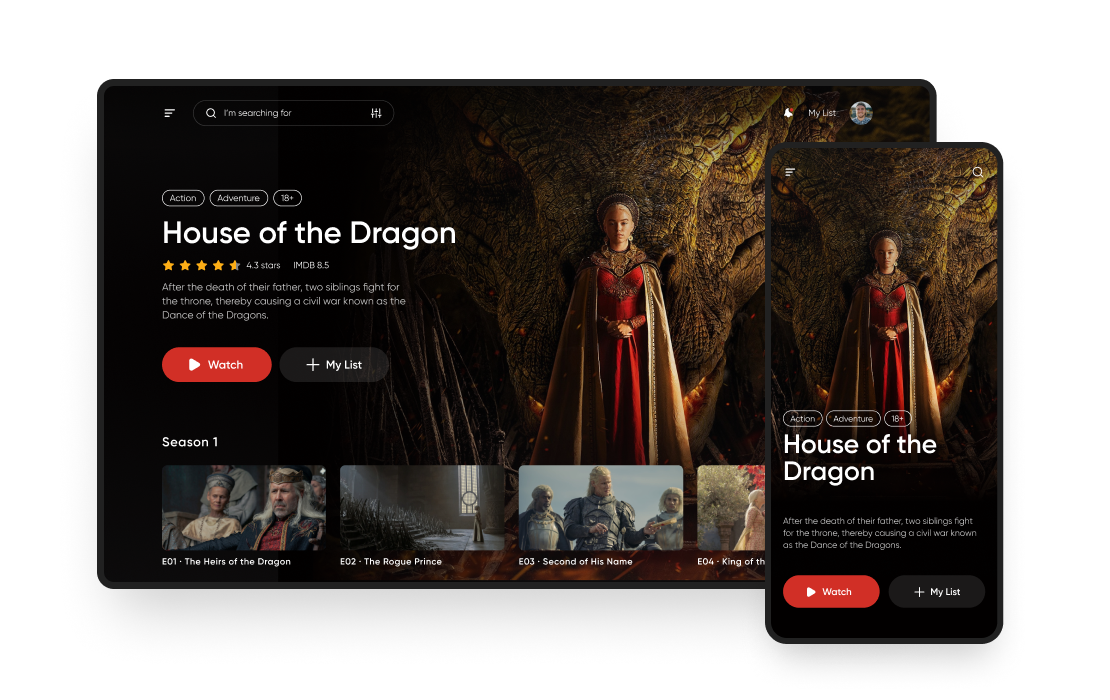
Rigorous content protection
As one of the key business requirements, the issue of security was given top priority and treated diligently by our specialists. The resulting solution included the following features:
- The internal video paywall, which is a part of a larger DAM (Digital Asset Management) system, effectively restricts free access to digital assets by requiring a viewer to purchase the video or pay for a subscription to access the content. Technical realization of this feature is based on the AWS Lambda Edge service, which processes the user's data to return relevant types of content. For example, the user with a subscription receives full access to the content, while an unsubscribed user will only see the preview or a video with ads.
- Integration of a digital rights management (DRM) solution has made it possible to prevent piracy and unauthorized usage of the customer’s digital assets. Andersen's specialists used different solutions to ensure multi-DRM support on the vast majority of playback devices. This required integration with three major DRM providers – Google’s Widevine, Apple’s FairPlay, and Microsoft’s PlayReady, which store and transmit content in an encrypted form – and the development of a key delivery service that conducts token verification and DRM licensing.
- A role-based access control (RBAC) system was implemented by our team, which restricts access to certain content according to the user’s permissions determined by the subscription type and authorization configurations.
- Additional security features include content geoblocking, preventing downloads, watermarking, and disabled screen recording.
User-friendly interface
Andersen's design team conducted thorough UX research to identify key usability standards. As a result, we outlined and implemented several features leading to a significant improvement in user experience:
- Smooth authorization on multiple devices. Particularly, it concerned the poor experience of authorization on Smart TVs, which used to require entering credentials via a remote control. The solution we delivered includes QR-code scanning and OTP entering, which automatically synchronizes users’ accounts on mobile and Smart TV devices.
- Responsive interface. Andersen's solution allows users to create personalized playlists, benefiting from adaptive menus and intuitive navigation through page hierarchy.
- Multiple language support. This feature has made the content available to people all over the world and led to audience growth. Andersen's experts have completed app localization for five languages.
- Offline viewing. A feature for only premium subscribers ensures the possibility to view pre-saved content on mobile devices without an Internet connection.
- Second screen. The capabilities of our solution are not limited to the basic feature of second-screen connection and synchronization with the VOD content. It also includes automatic content recognition (ACR), enabling the detection of broadcasted ads, TV series, or movies on a companion device and synchronization of its content.
- Accessibility standards. For the advanced subscription plans, we have implemented audio descriptions and video scripts.

Content management
The back-office app we have developed allows admins to easily manage content by sorting videos into different categories, tags, or folders. It also makes content easily searchable, which gives the possibility to perform bulk actions on multiple videos. Content management was especially important for our VOD solution, as it was required to provide the admins with different permissions for managing, uploading, and publishing content to user accounts. The app also offers functionality for adding subtitles and logos and editing videos.
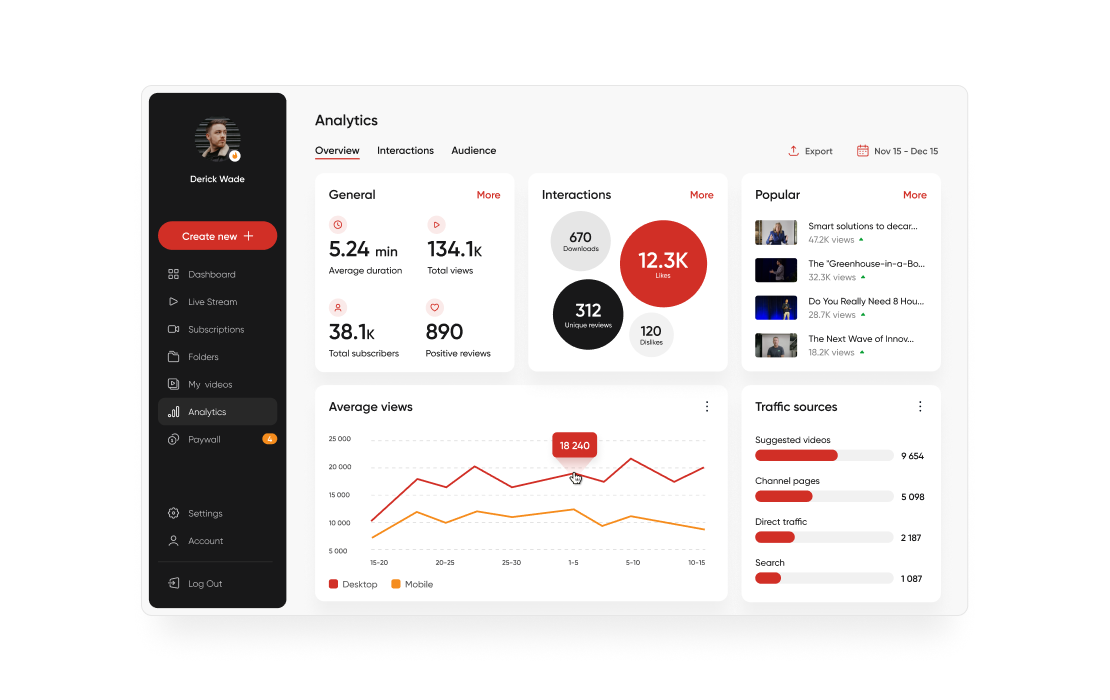
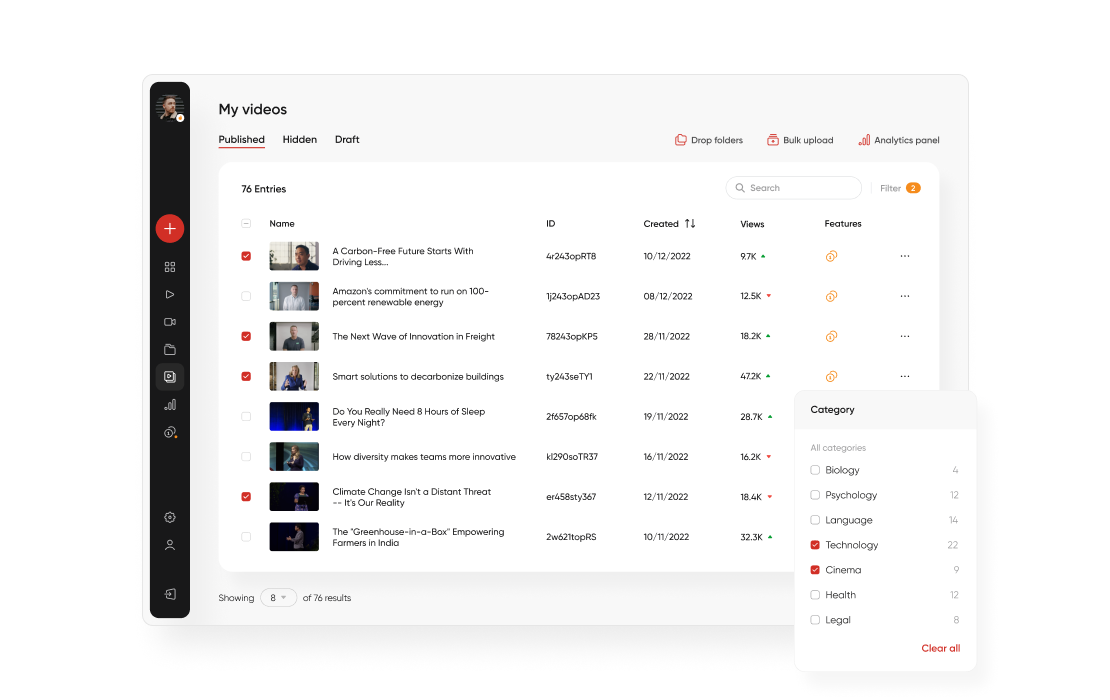
Recommendation engine
Andersen's ML experts have tailored AI-driven recommendation patterns specifically to the customer's requirements using Amazon Personalize. It includes API operations for real-time personalization and batch operations for bulk recommendations and user segments. Engine customization required scrutiny in setting up, according to the dataset and schema requirements, and large amounts of content metadata and user personal data under GDPR to train the models.

Coding/Transcoding flow
Andersen sticks to the best practices and conventional approaches in terms of data encoding, so our team chose AWS Elemental MediaConvert as an encoding tool, Advanced Video Coding (H.264) as a video codec, Advanced Audio Coding as an audio codec, and MP4 as a container format. We opted for these codecs because they ensure sufficiently high upload bitrates without leading to any loss of data. Video is streamed in 720p by default. AWS Elemental MediaConvert transcodes an input media file from the processing queue to the HLS format. After input files are specified, input selectors for video, audio, and captions elements are identified. Then, output groups with standalone package renditions are created. After transcoding is executed, the transcoded file is saved in the output location that was specified in the settings of the output group.
The flow of content downloading via CDN
The user sends a GET request to receive particular video content to the Amazon CloudFront CDN server via a link. Amazon CloudFront conducts checks of the user’s authorization parameters via the AWS Lambda Edge paywall. If the user is authorized and granted permission to access a chosen content type, AWS Lambda Edge sends a request to AWS Elemental MediaTailor to generate content with integrated ads. Then, AWS Elemental MediaTailor sends requests to:
- S3 Output Bucket where the content in the HLS format and VMAP file are stored,
- Ad Server Bucket where ads are stored.
Users support desk
Andersen's development team was responsible for implementing an online chat as a convenient means of reporting issues within the system. We released a support flow via integration with the Zendesk CRM service provider and Amazon Connect. A Contact Control Panel (CCP) is used to handle support tickets and communicate with contacts. The user support flow is executed according to the following pattern. The user sends a support request via the CCP's interface. The created support ticket is sent to Zendesk's support service, which is integrated with Amazon Connect. Subsequently, the user is able to communicate with the support team via text or voice channel using the out-of-the-box Zendesk interface.
Advanced video player
Andersen's video player solution includes the customization of an HTML5 Video Player – not only because it is compatible with HLS ingest but also because many set-top boxes and Smart TVs don’t meet the processing and memory demands of OTT apps. The player provides users with a broad range of features, including instant and basic playback, play/pause, seek, time display, volume control, normal and full-screen display, and captions/subtitles. We have also included multilingual audio track selection, auto adjustment of resolution depending on the quality of the Internet connection, and responsive layout for consistent relative player size.
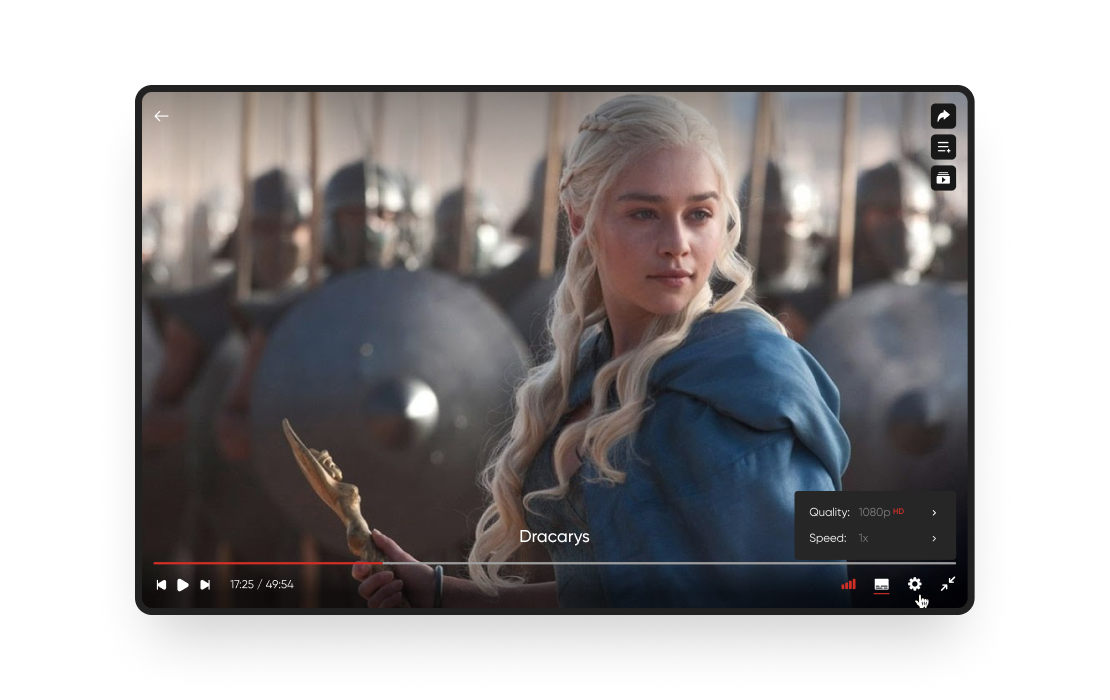
Here is a high-level overview of the successful business flow and components described in the diagram:
Authentication.
The user logs in to the app - The user enters credentials - The system sends the request to the Amazon Cognito service - The user is authenticated.
Content uploading.
The admin uploads the content in the RAW format via AWS AppSync (a GraphQL-based API gateway) to activate the AWS Lambda service (video upload). In such a way, the content is uploaded to Input Bucket (S3 object-oriented storage).
The workflow of AWS Step Function.
After content is uploaded to Input Bucket, the system runs an internal Step Function workflow. It includes the following steps:
- The AWS Elemental MediaConvert service converts the content from RAW to HLS, which is suitable for streaming purposes. All data is stored in Amazon DynamoDB.
- The Amazon Rekognition service conducts recognition of the content to identify the best places to insert ads. It also extracts content metadata, including labels, celebrities, and brands, to make ads even more targeted and context-oriented.
- The AWS Lambda service detects and scores ad insertion slots based on extracted metadata.
- The AWS Lambda service generates a VMAP file that includes ad metadata and mapping of the top-scored video slots where ads will be stored.
- Then, the HLS video and corresponding VMAP file are uploaded to Output Bucket.
Redirection of the prepared stream to the user.
The AWS Elemental MediaTailor service conducts extraction of the video content from Output Bucket and ads from Ad Server Bucket. Then, it merges the ads with the relevant slots in the video according to the VMAP file. The created stream is redirected via a single link to Amazon CloudFront and displayed to the user.
Access to the content.
Amazon CloudFront works as a content distribution management system that caches content and ad segments. Simultaneously, AWS Lambda Edge is enabled to conduct a paywall integration service that processes data about the user to return relevant types of content.
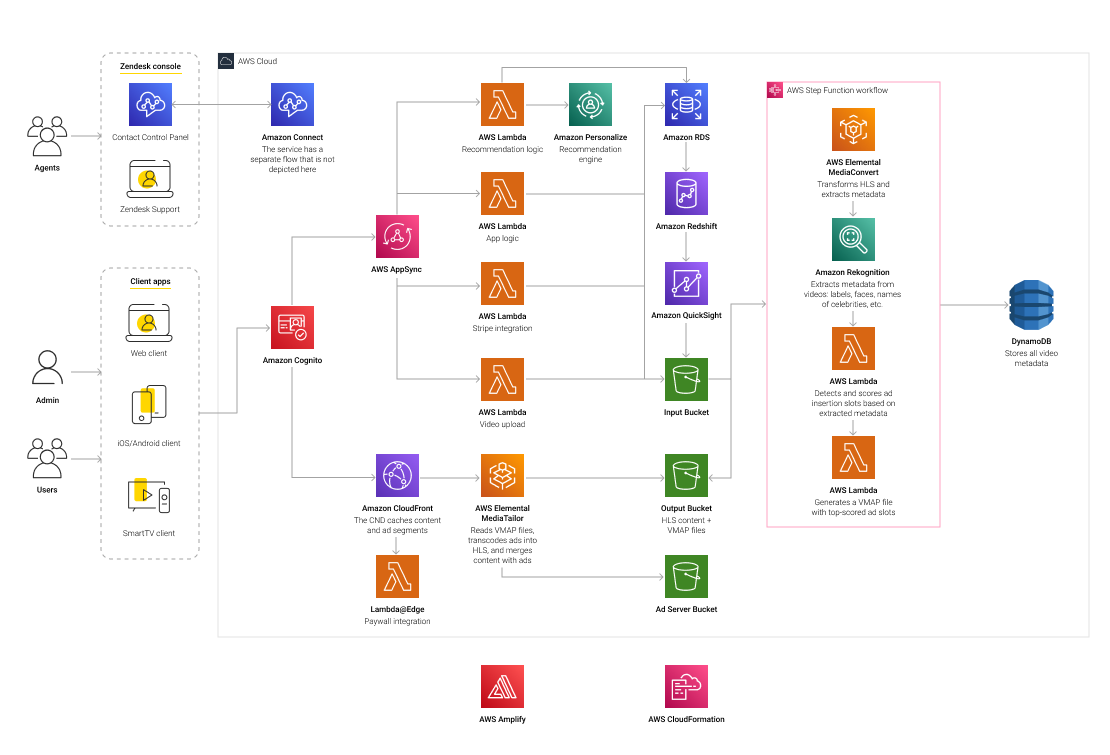
BI and reporting module
- Amazon RDS – a service for storing relational databases where all indicators from the content are located.
- Amazon Redshift.
- Amazon QuickSight – a service for visualizing the analyzed data and generating charts and reports.
Deployment
- The AWS CloudFormation service was used by us for the deployment of our system in the cloud.
- AWS Amplify – a library that ensures the correct operation of a single-page app with cloud and integrations.
Impact
- The delivered platform has attracted more than five million active users within six months of the MVP release. Subsequent releases have led to an average monthly increase of subscribers by 17%, allowing the customer to reach more than ten million users within the first year of the deployment (as of the statistics for 2021).
- The company’s share in the local VOD market has reached the 9% mark and is gradually growing, even though there is fierce competition with global VOD providers.
- The combination of multiple monetization models has proven to be efficient in terms of generating revenue and increasing customer retention rates. Reports show that the customer's revenue has grown by 32% within six months of the MVP release, while monthly retention rates are consistently at the 75% level.
- The above achievements allow the customer to attract more content makers and advertising contracts, which has resulted in the rapid broadening of the content catalog. Moreover, the accumulated resources are driving the business towards establishing its own content creation studio and releasing unique videos.
BA activities
- Conducting market research to define the current trends and main user pain points;
- Investigating modern digitalization practices and tools to apply them to the solution;
- Creating user personas and workflows;
- Designing a custom VOD solution with the usability, performance, and security compliance aspects prioritized;
- Collaborating with multiple stakeholders;
- Managing the project backlog;
- Leading the user acceptance testing process.
Decomposition of the "Video content management" epic

Project results
- Andersen's team has delivered a platform that fully meets the needs of our customer and their end-users;
- The audience has increased thanks to the platform's high usability and performance;
- Several monetization models have been designed to provide end-users with access to the platform;
- With the help of our BA team, the security compliance processes have been set up and applied to the solution to ensure a high level of content and user protection.
Let's talk about your IT needs
What happens next?
An expert contacts you after having analyzed your requirements;
If needed, we sign an NDA to ensure the highest privacy level;
We submit a comprehensive project proposal with estimates, timelines, CVs, etc.
Customers who trust us
